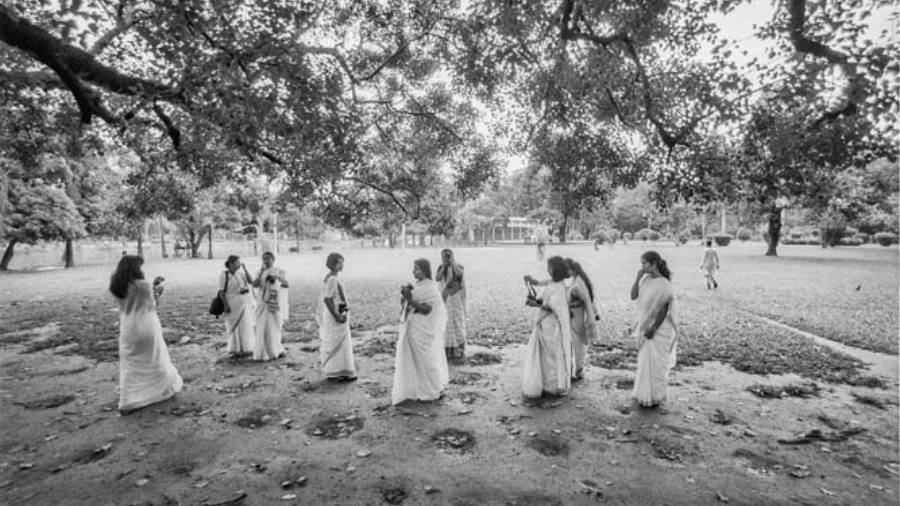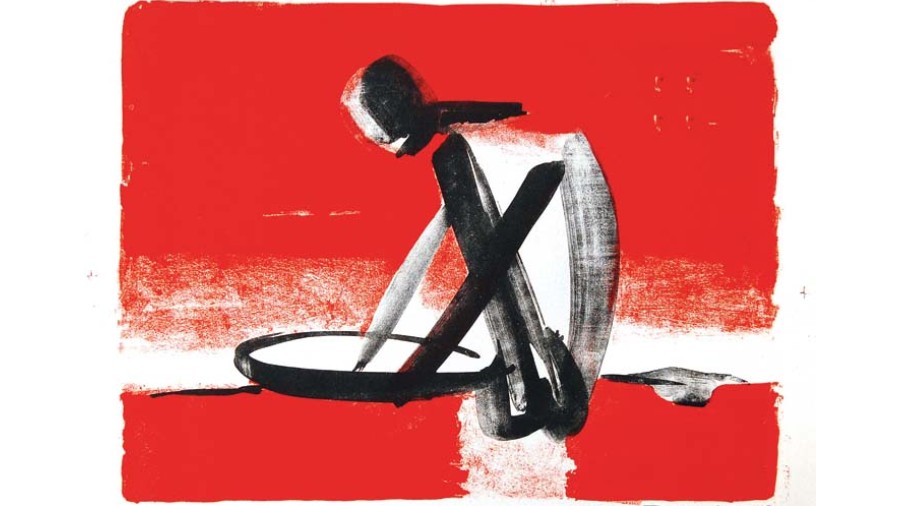On June 18, we open three major exhibitions of Arunima Choudhury, Somnath Hore and Shahidul Alam at Emami Art. It is a day of sharing the joy of creative expression with the city’s art lovers. As soon as the waves of the pandemic settle, we, like most major galleries in India, welcome our audience in search of aesthetic pleasures, offering thought-provoking curated shows, seminars, workshops and live events. Although the three artists are apart by time, style, approach and medium, they all show profound conviction in the power of art as an agent of change. The universal language of art, which speaks of the essence of humanity, transcends the economic, geographic and historical barriers that confine us.
The Dark Edge of Green
Curated by Nancy Adajania, the noted curator and writer based in Mumbai, The Dark Edge of Green, a retrospective-scale show of Arunima Choudhury, will feature the artist’s finest work in the last three decades, between 1995 and 2022. I have long been familiar with Choudhury’s work, whose career spans about 60 years in this city. I am fascinated with her instantly recognisable style, freshness and spontaneity, untouched by the restlessness of city life.
Choudhury is mainly known for her paintings on handmade paper, particularly in botanic colours, which she makes from flowers, vegetables and seeds. In the large body of her paintings on display, one can see her use of limited hues — green, yellow and dark blue — brilliantly activate the pictures’ pictorial space and inner tensions. Besides paintings on paper, the exhibition shows her rarely shown fabric and ceramic work and enamel paintings.
“I have structured this exhibition around two stories — an artist memoir written in 1999 and a recent family anecdote. To re-animate Arunimadi’s childhood memory of finding her classmate Bina Das’s body in the mora kata ghor or autopsy cell in Siliguri, we have specially created a cell-like installation that breaks into sharp angles at strategic points. While the memoir invokes fear and forbidden desires, among other turbulent emotions, it also proposes a cathartic means of overcoming fear, which is weaponised by the patriarchy to ‘show women their place’ in society. The accompanying selection of watercolours, Beastly Games and Other Love Stories (2008-2010), does not illustrate the memoir. Instead, it functions as a testament to Arunimadi’s irrepressible subconscious and her transgressive energy, which re-wilds women, trees and tigers in equal measure. The second story is an exchange between the artist and her granddaughter about the ethics of mending and repairing the planet by living in a mindful manner. It is nestled in a series of eco-prints on cotton and rice paper. Luminous but no less edgy, these sombre impressions of leaves — guava, neem, lotus and rose — are as much psychological portraiture achieved through Rorschach twinning, as they are a meditation on slow time and interspecies hospitality,” said Adajania, about curating this exhibition.
Nature has long been central to Choudhury’s creative imagination. It operates at many levels, as external reality and organic materials, as well as internal drives and emotions. Deeply ingrained in the rich traditions of vernacular literature and autobiography, she nurtures a woman-ly worldview that does not separate nature and the environment from the human world. Her work reveals as much as it hides the complexity of the relationship, constituting her visual poetics. A fruitful outcome of a long and intense conversation between the artist and curator, this exhibition throws light on the lesser-known aspects of her practices.

Shahidul Alam's work
Singed but not Burnt
Well-known writer and columnist Ina Puri is instrumental in bringing Singed but not Burnt, a significant survey exhibition of famous Bangladeshi photographer Shahidul Alam, to the city. Puri has known him well for decades and convinced us of the relevance of his work in today’s fractured world.
The exhibition brings together a substantial body of his work spanning four decades of his eventful career, from his stunning images in the early 1980s when he was a PhD student in the UK to his mature political photographs for which he is widely known.
“Especially relevant at a time when freedom of speech and expression is being challenged the world over, the powerful work of Shahidul Alam is like a beacon of light and hope that gives the common man long denied his and her rights, a voice to protest against this grave injustice. Featuring portraits, landscapes devastated by climate change, images of the daily strife and rigour of the ordinary man in the streets who has to struggle through poverty and social inequality to make ends meet, Shahidul Alam’s searing images bring alive issues that sometimes go unreported. The lens of the photographer remains focussed on the under-represented minority and never wavers, creating visual imageries that will linger forever in one’s consciousness,” said Puri.
Among our time’s most influential photographers and documentarians, Alam is an insightful observer and an unflinching critic of human rights violations. He has passionately documented the major events affecting Bangladesh, striking a delicate balance between art and activism. It is an excellent opportunity to see the gripping visuals in his photographs, allowing us to rethink that art is not about decorating the walls but about asking elementary questions and exploring contradictions.

Artwork by Somnath Hore
